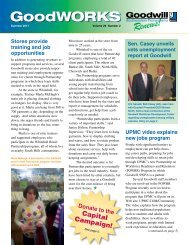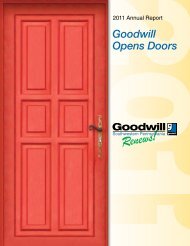Summer 2013 - Goodwill Southwestern Pennsylvania
Summer 2013 - Goodwill Southwestern Pennsylvania
Summer 2013 - Goodwill Southwestern Pennsylvania
Create successful ePaper yourself
Turn your PDF publications into a flip-book with our unique Google optimized e-Paper software.
Environmental Stewardship<strong>Goodwill</strong>’s extra-effortapproach to conservationalresponsibility.Widely recognized for many years as a leader in re-use andrecycling, <strong>Goodwill</strong> of <strong>Southwestern</strong> <strong>Pennsylvania</strong> employsa broad range of operational practices to minimize theenvironmental impact of the tons of donated items we receivebut cannot use or sell. Essentially, we have taken ourrecycling game to a new level over the past few years,significantly expanding and broadening our efforts to keepgreater quantities of materials out of landfills and to minimizethe cost of disposing of unusable materials.Saleable vs. Non-saleableThe nearly 130,000 pounds of donated materials that <strong>Goodwill</strong> receivesevery day can be divided broadly into two categories:Saleable items that we can potentially sell in our stores – such asapparel, housewares, books, shoes, etc. Saleable items that are notpurchased after a few weeks on the sales floor are recycled.Non-saleable items that are not suitable for sale because they are damagedor otherwise incompatible with our quality standards, including cardboardand scrap metals. Non-saleable materials are recycled immediately.Over the past three years, our extra-effort approach to conservational responsibilityhas kept an estimated 284,482 cubic yards of material out of landfills,the equivalent of nearly 2,000 tractor trailer truck loads.Donation GuidelineTo some extent, recycling has always been a necessary part of our businessbecause some donations are not in keeping with our long-standingguideline: give to <strong>Goodwill</strong> what you would give to a friend.We have to pay to dispose of donated items that cannot be sold or usedbecause they are broken, soiled, damaged, or simply “junk.”Our proactive approach to recycling has generated more than$12 million in revenues to help offset the costs of disposing of donatedmaterial that cannot be sold.Recycling StatisticsNon-Saleable Materials Recycled2010-2012ItemsPoundsCardboard................................902,636Scrap Metals.........................2,007,353Saleable Materials Recycled2010-2012ItemsPoundsApparel...............................26,449,121Housewares..........................3,617,723Hats...........................................35,545Belts...........................................49,328Purses.....................................730,399Plush........................................607,561Books....................................4,025,084Shoes.................................. 2,286,649Toys......................................1,555,836Electronics2010-2012Televisions..................775,401 poundsComputers ..............6,945,786 poundsCell phones......................... 5,399 unitsOther electronics..........52,561 poundsRecycled & ReusedYearPounds2010...................................21,533,5592011...................................20,628,3322012...................................22,071,513Total...................................64,233,40410







